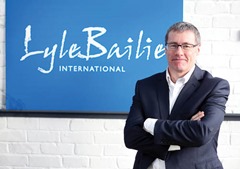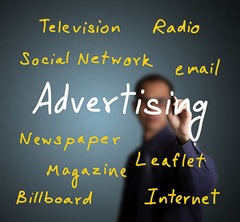The changing face of advertising
 Changing expenditure, technologies and consumer behaviour are reshaping the world of advertising, writes Robert Lyle, media director, Lyle Bailie International.
Changing expenditure, technologies and consumer behaviour are reshaping the world of advertising, writes Robert Lyle, media director, Lyle Bailie International.
We live in an age of constantly changing media contact ‘touchpoints’. Some call it media fragmentation but we just see it as extended choice.
These contact touchpoints are available and expanding and include outdoor advertising in all its standard formats and new TV now joined by smart TV, newspapers, magazines, radio and podcasting, cinema, direct mail, online, social media, apps, banners, search, gaming, branded content, mobile, sponsorship, experiential, events – and this list is not exhaustive.
This flux is true of the world of advertising as it goes about its business of reflecting and changing society’s ambitions, desires, attitudes and behaviour.
Expenditure change
In terms of advertising expenditure on media (and these figures exclude all production and design spends, the picture remains bleak. With the help of some key media suppliers in the marketplace, Lyle Bailie would estimate that the Northern Ireland advertising media market was worth £141 million in 2012. Not an unimpressive figure and one which helps to keep a lot of people in employment. However, it is the fourth year of consecutive decline (down 2.8 per cent on 2011) and we are back towards the levels of spend in 2000.
On a more worrying note, Northern Ireland punches well below its weight in terms of media spend per capita. Whereas the UK expenditure is around £220 per person, and the Republic of Ireland £132, in Northern Ireland the spend stands at around £77. Indeed, on a pro rata basis, the local market should be worth £390 million.
Part of the reason may be the lack of channels/media available. For example, Sky has no opt-out for Northern Ireland advertisers and neither (despite now having a significant audience) does RTÉ. The local industry is also too dependent on government advertising spend and when the Executive look for savings then advertising is often the first to suffer, despite the huge role it has had in saving lives and delivering value for money to the taxpayer.
A large number of client decisions are now made outside Northern Ireland for certain sectors such as banking, travel and fast moving consumer goods (FMCG) brands. At a population of 1.8 million, the local market is small and it would be great to see more of our large local brands expanding and advertising outside Northern Ireland – the local agency sector certainly has the expertise to help them grow their market share.
“Crowding out” has also been a concern in our small local market, where a well-funded BBC can be proportionally a bigger player in radio and online and can prevent the private sector from growing.
When we look at the allocation of media spend, we can see some of the more structural issues come into play. Comparing share of spend in 2000 to 2012 we can see that press has declined from around 47 per cent share to 25 per cent. TV has remained fairly steady at 40 per cent with outdoor, radio and cinema all growing.
Digital is the ‘new kid on the block’ with an estimated 7 per cent share which is significantly below the 30 per cent it takes in the UK and 20 per cent in the Republic of Ireland. Digital has now taken a significant part of the classified spend from press and continues to grow, we estimate, by around 9-10 per cent year on year.
Behind changing expenditure lies changing technologies. Technological change in media has accelerated in the last decade. Digital TV is now the norm in 98 per cent of homes after switchover with Northern Ireland being on par with the UK average. Broadband take-up is high at 69 per cent and we still outstrip the UK for superfast availability.
Mobile broadband is growing fast with smart phone ownership in 2012 in Northern Ireland being recorded at 34 per cent – this is likely to be over 50 per cent now. And tablet ownership is likely to have grown above the 9 per cent figure to over 20 per cent on the back of all those 40-pluses who find smartphones too small. Digital radio is low in Northern Ireland where at 22 per cent reach we lag well behind the UK average where the figure is 38 per cent.
There are many areas of technological change, including the advent of the screen-dominated media world with the average person spending 1.9 hours on the internet, 1.2 hours on their mobile screen and 4.3 hours with the TV screen each day. Mobile will remain crucial with local ownership at over 90 per cent and smartphone ownership is rising by around 13 per cent year on year. Mobile brings with it the possibility of accessing consumers in lots of areas and brings with it a paradox – it has allowed consumers to become increasingly spontaneous, they can make plans or change them with the press of a button.
At the same time, the internet itself is making consumers more risk-averse as they use peer reviews and price comparison sites as a comfort blanket before they buy. Along with screens and mobile comes the challenge of big data which allows correlations to be found to spot business trends, determine quality of research, prevent diseases, combat crime, and determine real-time roadway traffic conditions.
Ad-avoidance technology remains a buzzword these days. Just as there has been great advertising down the years there has also been lots of bad advertising. And just as consumers have enjoyed adverts, some have sought to screen it out. Undoubtedly skipping ads will increase in future but if the past 6-7 years is anything to go by, this will be a slow process and campaigns will simply become more multi-channel and multi-media.
How has the media consumer reacted to all the technological change in the marketplace over the last decade or so? There have been major changes in media coverage by the main media channels amongst adults from 1998 to 2012.
There are some clear changes:
• a significant decline in the reach of daily/Sunday press from 74 per cent reach to 54 per cent (though these figures do not show what the combination of print and online readership is);
• a less significant decline by weekly paid-for press from 64 per cent to
59 per cent (again with no figures combining print and online);
• the internet has grown from 3 per cent reach monthly to 68 per cent with major global brands such as Google, facebook, YouTube and twitter driving audience and other local sites offering significant but smaller audiences;
• the main outdoor formats of 48 sheet, Adshel and bus externals have grown from 60 per cent reach to 66 per cent;
• mobile ownership from 8 per cent to 92 per cent;
• responding to direct mail from 12 per cent to 27 per cent;
• watching commercial TV monthly remains high at over 90 per cent although most campaigns themselves will deliver coverage in the 80-90 per cent range (coverage would be maintained and raised with the extension of Sky or RTÉ into the Northern Ireland market plus BT Sport from August onwards);
• commercial radio (fired by the addition of new stations and the
re-energising of existing ones) has grown from 65 per cent to 71 per cent coverage.
There needs to be a move away from research which just looks at the single platform reach of media and which allows media planners/buyers to look at the total audience delivery across all platforms, and we need media to move to sell this overall audience on a simpler ‘cost per thousand’ basis.
We should remember that consumers engage with ideas, not media. Not only is it important to buy placements in the right place at the right time, but it’s important to fill the placements with persuasive content. As research company Millward Brown has pointed out: “The best creative is 30 times more likely to be stopped and watched than the worst. The worst ad is 5.5 times more likely to be fast forwarded than the best.” It has been established by the IPA that in the UK, the average individual’s exposure to ads is 1,009 daily and this means that getting attention is the most precious commodity in advertising.
Changing approaches to advertising
New views of consumer behaviour have themselves led to new approaches to advertising and these include: the paid, earned, owned media approach and its implications; the interruption or engagement fallacy; the evidence around the success of a multi-media channel approach; the growing concern towards over-segmentation in marketing; the role of neuroscience and psychology; and the role of market mix modelling (econometrics).
The terms “earned, owned and paid media” have become very popular and taken together they can be applied as a simple way for marketers to categorise and ultimately prioritise all of the media options they have. Paid media is bought such as TV, press, outdoor, radio, direct marketing and cinema. Earned media (or free media) refers to public relations, social media, virals, word of mouth or online “buzz” and third party blogs. Owned media is the primary type of content and media that a client creates and owns themselves such as the client website, the company blog or e-zine, company twitter or facebook pages, email marketing, mobile notifications, apps and (by extension) packaging, distribution and property branding and internal communications
The use of this compartmentalisation has helped marketing directors leverage all the tools at their disposal to communicate with consumers. All your employees (even non-sales staff) are potential brand ambassadors. However, the difficulty arises when marketeers think that by increasing earned and owned media that they can do without paid media. The evidence would suggest otherwise. Thinkbox, the marketing body for commercial TV in the UK, unveiled in March 2013 a brand new econometric study called Poetic.
Produced by Data2Decisions, the study examined over half a million data points for 36 brands to reveal exactly what the relationship is and how it works. It established that 47 per cent of website traffic came from paid TV; 22 per cent of website traffic came from other paid media such as press, radio and outdoor; 40 per cent of buzz and brand word of mouth is generated by paid media. Marketing works best when all elements (earned, owned and paid media) work together.
Econometrics
There is an increasing role of data in advertising. It is time that clients commissioned econometric studies to show: What return their marketing investment is giving the business/organisation? What media is working and what isn’t? How to improve for the future?
Examples of what studies can show are as follows:
• for the return on investment on road safety advertising, Oxford Economics showed the economic payback in Northern Ireland between 1995 and 2011 was £10 per £1 invested in advertising, excluding human costs and £42 per £1 invested in advertising, including human costs;
• for Moy Park in the Republic of Ireland, there was a €2.13 return for every €1 spent (based on chicken kievs),based on the full Moy Park range; €10.65 return for every €1 spent.
Future
Advertising will continue to change in its delivery both by media and through the creative it employs. It will adapt to technological change and consumer behaviour change. Great advertising will still deliver change itself – to sales, to market share and to behaviour – and it will be able to demonstrate the economic and social value of that change in real, hard monetary terms.






